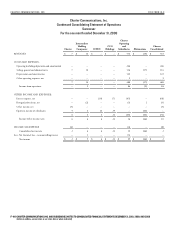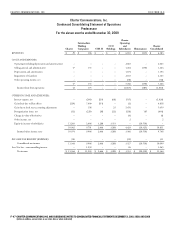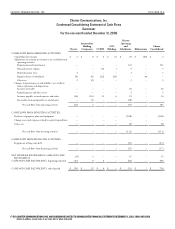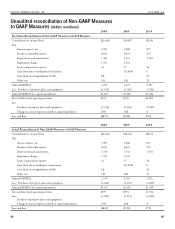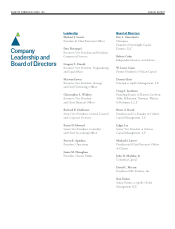Charter 2010 Annual Report Download - page 139
Download and view the complete annual report
Please find page 139 of the 2010 Charter annual report below. You can navigate through the pages in the report by either clicking on the pages listed below, or by using the keyword search tool below to find specific information within the annual report.
e Company uses certain measures that are not defined by
Generally Accepted Accounting Principles (“GAAP”) to evaluate
various aspects of its business. Adjusted EBITDA, adjusted EBITDA
less capital expenditures and free cash flow are non-GAAP financial
measures and should be considered in addition to, not as a substitute
for, net income (loss) and net cash flows from operating activities
reported in accordance with GAAP. ese terms, as defined by
Charter, may not be comparable to similarly titled measures used by
other companies. Adjusted EBITDA is reconciled to consolidated net
income (loss) and free cash flow is reconciled to net cash flows from
operating activities
in this annual report.
Adjusted EBITDA is defined as consolidated net income (loss) plus
net interest expense, income taxes, depreciation and amortization,
reorganization items, impairment charges, gains related to our
emergence from bankruptcy and fresh start accounting adjustments,
stock compensation expense, gain (loss) on extinguishment of
debt, and other expenses, such as special charges and loss on sale
or retirement of assets. As such, it eliminates the significant non-
cash depreciation and amortization expense that results from the
capital-intensive nature of the Company’s businesses as well as other
non-cash or special items, and is unaffected by the Company’s capital
structure or investment activities. Adjusted EBITDA less capital
expenditures is defined as Adjusted EBITDA minus purchases of
property, plant and equipment. Adjusted EBITDA and adjusted
EBITDA less capital expenditures are used by management and the
Company’s Board to evaluate the performance of the Company’s
business. For this reason, they are significant components of Charter’s
annual incentive compensation program. However, these measures
are limited in that they do not reflect the periodic costs of certain
capitalized tangible and intangible assets used in generating revenues
and the cash cost of financing. Management evaluates these costs
through other financial measures.
Free cash flow is defined as net cash flows from operating activities,
less purchases of property, plant and equipment and changes in
accrued expenses related to capital expenditures.
e Company believes that adjusted EBITDA and free cash flow
provide information useful to investors in assessing Charter’s
performance and its ability to service its debt, fund operations and
make additional investments with internally generated funds. In
addition, adjusted EBITDA generally correlates to the leverage ratio
calculation under the Company’s credit facilities or outstanding
notes to determine compliance with the covenants contained in
the facilities and notes (all such documents have been previously
filed with the United States Securities and Exchange Commission).
Adjusted EBITDA, as presented, includes management fee expenses
in the amount of $144 million, $136 million and $131 million for
the years ended December 31, 2010, 2009, and 2008 respectively,
which expense amounts are excluded for the purposes of calculating
compliance with leverage covenants.
Upon our emergence from bankruptcy, we adopted fresh start
accounting. is resulted in a new accounting basis and therefore, the
consolidated financial statements on or after December 1, 2009 are
not comparable to the consolidated financial statements prior to that
date. For purposes of this annual report, the eleven months ended
November 30, 2009 of Charter (the “Predecessor”) and the one
month ended December 31, 2009 of Charter (the “Sucessor”) have
been combined to present the year ended December 31, 2009 results
of operations for the Predecessor and the Successor. is combined
presentation is being made solely to compare the combined results of
operations for the year ended December 31, 2009 with 2010 as we
believe this presentation provides a more meaningful perspective on
our ongoing financial and operational performance and trends.




